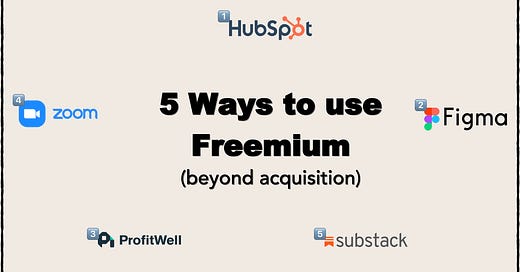SaaS Pricing is hard. PricingSaaS is your cheat code.
Monitor competitors, track real-time benchmarks, discover new strategies, and more.
Happy Friday and welcome new subscribers!
Everyone knows a freemium strategy is a great way to drive acquisition for an existing product — but it can also be a great way to achieve other strategic goals.
Today, I’m sharing 5 of my favorite Freemium use cases, and examples of companies that have nailed the execution.
Let’s get to it.
This email is brought to you by PricingSaaS.
SaaS pricing is complicated, and besides ProfitWell, there aren’t many places to turn for help. PricingSaaS is a cheat-code that lets you:
Track pricing trends across the SaaS landscape 📈
Benchmark pricing and packaging for your industry 🎯
Get instant alerts when competitors change their pricing page 🔔
Below are 5 creative Freemium strategies that have stuck with me. If you can think of others, I’d love to hear them in the comments!
1️⃣ Enter a new market
If you already offer one product, and are looking to expand into a new direction, offering a freemium product can be a great way to do so.
Example: Hubspot was originally known for marketing software, but in 2014, they launched a free CRM. Over the past decade, they’ve become a true challenger to Salesforce, and the preferred CRM option for most startups.
2️⃣ Get Product Feedback
An underrated part of a Freemium strategy is that it allows you to collect tons of usage data. This can help determine what customers value, and how to properly price the product.
Example: In April of 2021, Figma released a digital whiteboard tool called FigJam. The best part? FigJam would be free for the remainder of 2021. That gave the Figma team 8 months to watch users engage with the product and make it better by the time they started charging.
3️⃣ Drive Demand for Other Products
Commoditizing the complement is one of my favorite strategies in business, and its based on an economic concept. Simply put, if the price of a complementary product goes down, the demand for your product will go up.
Example: ProfitWell offered its SaaS metrics solution for free, forever. The logic went like this — if getting accurate SaaS metrics is free, there will be more demand for products that improve those metrics. That’s exactly what happened as ProfitWell monetized through Price Intelligently and Retain, leading to a $200m exit.
4️⃣ Reset Customer Expectations
Launching a freemium plan with creative usage limits can recalibrate customer expectations, and change the value equation of an industry.
Example: When Zoom entered the scene, videoconferencing incumbents were thrifty with meeting participants. Webex, the market leader at the time, only allowed 25 meeting participants on its Premium plan. By offering 50 meeting participants on their free plan, Zoom changed that immediately, causing competitors to rapidly follow suit.
5️⃣ Align with a Mission
If your company is mission-driven, offering your product for free can help align incentives, and instill confidence in your intentions.
Example: Substack’s mission is to democratize the tools needed for a writer to build an independent business. Their platform is free until a writer starts charging for their work. This gives Substack skin in the game, and aligns their incentives with the writers on their platform.
Thanks for reading! If you enjoyed this post, consider liking it, subscribing, or sharing with a friend so Substack shows me some love.




